
Woody 2014-15
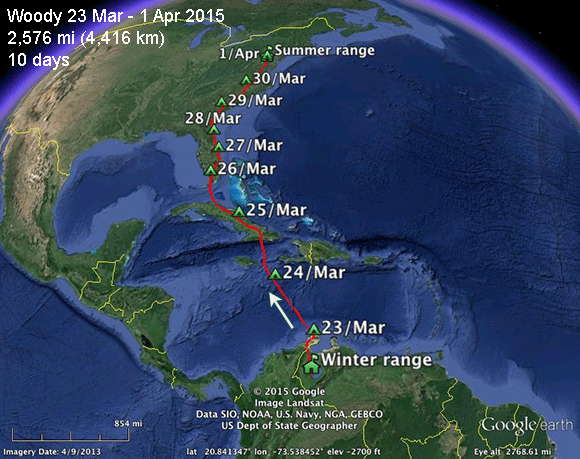 |
Spring migration over in a flash.Woody left his winter area on the 23rd and spent the night on the Guajira Peninsula. He started flying just after 8:00 am local time on the 24th and was over the Caribbean about an hour later. Then the mad dash began--57 hours from South America to the Florida Keys! From that point on, it was pedal to the metal. He arrived at home in the northern Chesapeake Bay on April 1st, a full 7 days ahead of his schedule last year. Scroll on for details, beginning with his fall migration last year. |
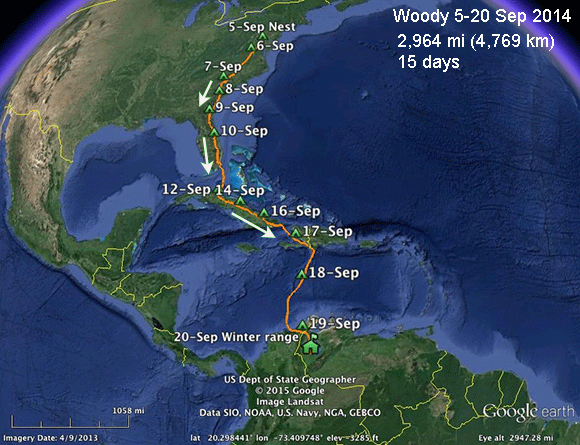 |
Woody heads south - Fall 2014Woody made quick work of his 2,964 mi (4,769 km) trip from his nest in the upper Chesapeake Bay to his winter range in the Cienagas (swamps) of Juan Manuel National Park, southwest of the Lake Maracaibo, South America's largest lake (I missed this clue in a crossword!). |
Woody heads south - Fall 2014Woody . |
|
Woody heads south - Fall 2014Woody . |
|
Woody heads south - Fall 2014Woody . |
|
Woody heads south - Fall 2014Woody . |
|
Woody heads south - Fall 2014Woody . |
|
Woody heads south - Fall 2014Woody . |
|
Woody heads south - Fall 2014Woody . |
|
Woody heads south - Fall 2014Woody . |
|
Woody heads south - Fall 2014Woody . |
|
Woody heads south - Fall 2014Woody . |
|
Woody heads south - Fall 2014Woody . |
|
Woody heads south - Fall 2014Woody . |
|
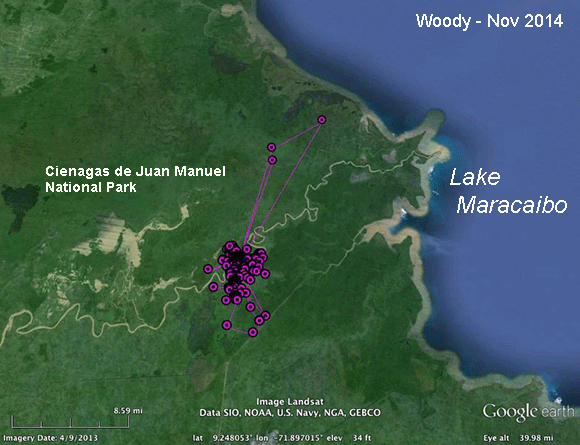 |
Back on his winter watersWoody settled down in November along the Catatumbo River in the Cienagas de Juan Manuel National Park in far western Venezuela. This is where he spent last winter, and where Buck, a juvenile we tagged in South Carolina, spent his winters. The next series of maps will track how he shifts his foraging over the course of the winter, presumably in response to changing availability of fish in the area. |
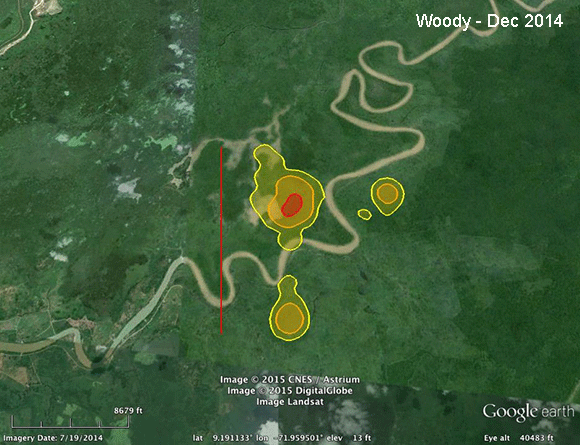 |
Lots of fish in one placeFor the whole month of December, Woody was very content to be a real homebody. These "kernel home range" maps show where 50% (the red shape), 95% (orange) and 99% (yellow) of his locations were over the course of the month. The red area would be his favorite perch for roosting or resting. He obviously could find all he could eat without any trouble. The red area is 0.1 square miles. For scale, the red line is 3/6 miles (5 km). An Osprey during the winter can probably get by without having to catch a lot of fish. The engine's on idle--no young to feed, no lond distances to migrate. Just chillin'. |
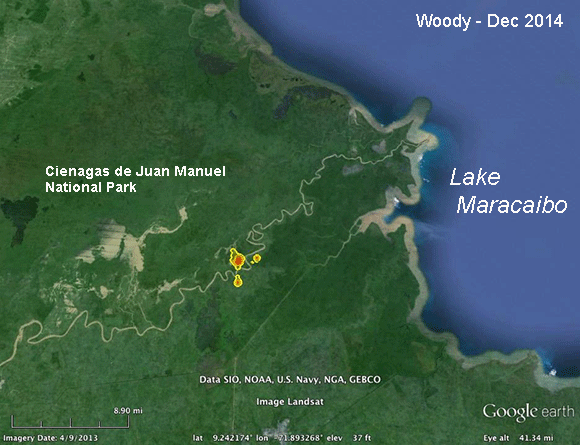 |
December rangeHere's the same range on the scale we need to show his monthly movements for the rest of the winter. |
 |
January 2015The fishing must have changed, because Woody did quite a bit more traveling in January than he did in December. The distance from the top of the yellow range to the bottom is 33 miles (54 km). Most of his time was spent where he was in December. This is unusual for an adult. Typically, they spend their winters in a much smaller area than Woody does. That's a big part of why the adults suffer so little mortality during their winter stays. |
 |
February 2015Now we see a shift of his attention up to the shores of Lake Maracaibo. (Ignore the gap in the yellow (99%) range--just a computer glitch of some sort.) |
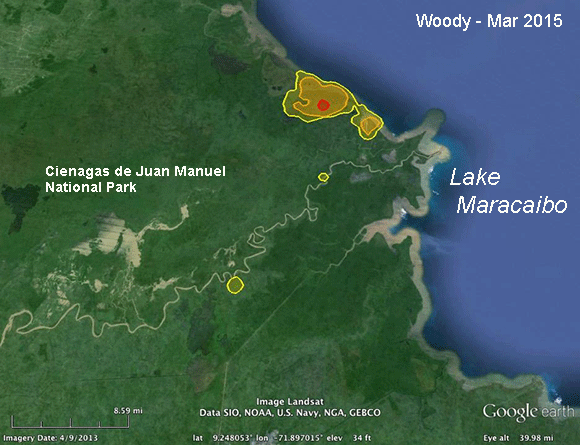 |
The last three weeks of vacationWe didn't hear from Woody from the very beginning of March until he was in Florida three weeks later. I was beginning to get a bit worried, because we had signals from him pretty reliably throughout the winter. This map explains what happened. The cell tower he "uses" must be down in the southern part of the area he uses. For some reason he abandoned that area completely for almost all of March. |
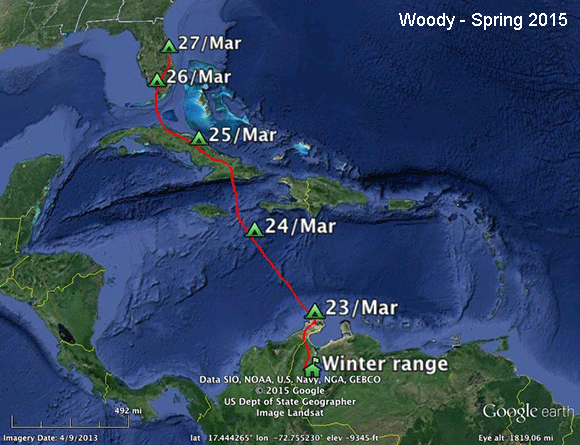 |
Spring migration 2015 beginsWoody left his winter area on the 23rd and spent the night on the Guajira Peninsula. He started flying just after 8:00 am local time on the 24th and was over the Caribbean about an hour later. Then the mad dash began. He didn't pass over Jamaica, as he did last year, but flew straight to Cuba. He arrived there at 11:31 on the 25th, about 26 hours after he left Colombia. He did not stop for a minute, but kept right on flying for another 6 hours. He finally settled down for the night at 5:50 pm. While he didn't get going the next day until 9 am, there's no indication he had any inclination to fish. Shortly after leaving his roost for the night of the 25th he flew right over a reservoir. He kept right on going and didn't stop until he got to the Everglades in southern Florida around 7:50 pm. There's again no indication that he was interested in fishing (we can say this with a fair bit of confidence when birds are wearing cell-tower transmitters because we get as many as 60 locations/hour, so there's hardly any time they could sneak in a bit of fishing). He took off again just after 9 am and flew up to Vero Beach on Florida's Atlantic coast. He's traveled traveled 1,624 miles in 5 days (That's 102,917,003 inches, as my young traveling companion Drew Clark pointed out). 57 hours from S.A. to Florida is astonishing! On an empty stomach, no less. |
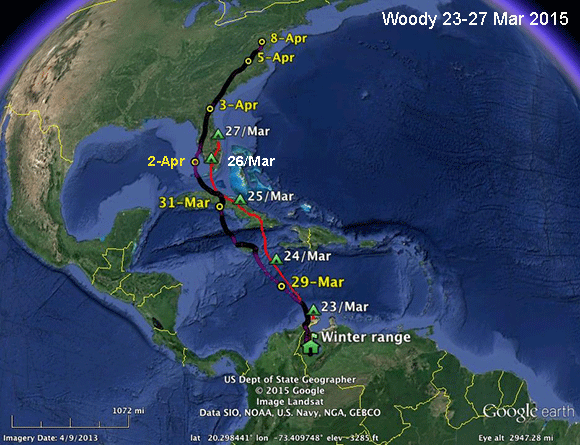 |
Heading home in 2015 vs. 2014In this map, his 2015 trip is the red line/white date labels. The darker line with yellow dates is his trip in 2014. In 2014 he left on Mar 28th. This year he started with a 5 day headstart, and with the mad dash across the Caribbean, he added 3 days to his lead over 2014. He should be home on the Chesapeake well ahead of his 8 March arrival last year. |
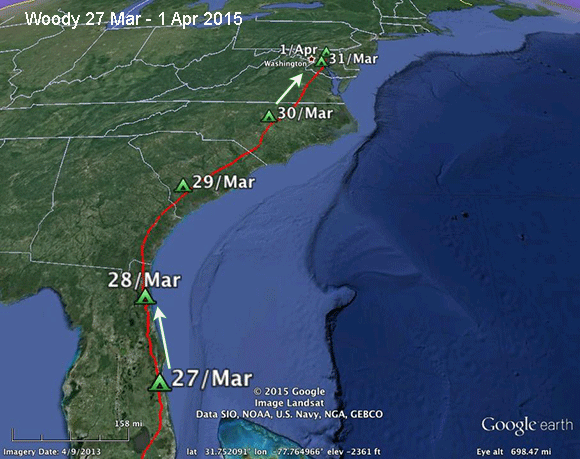 |
Home againWoody, like all our birds who were heading north through the mid-Atlantic states in late March and early April, caught some wicked tailwinds and made some really good progress. From the 27th through the 31st he traveled 900 miles in 4 days. Over the last 3 days of the period he covered 250 miles/day. He was close to home when he settled down for the night on the 31st, 30 miles southeast of Washington, DC, and 40 miles south of his nest. He arrived at noon on the 1st. |
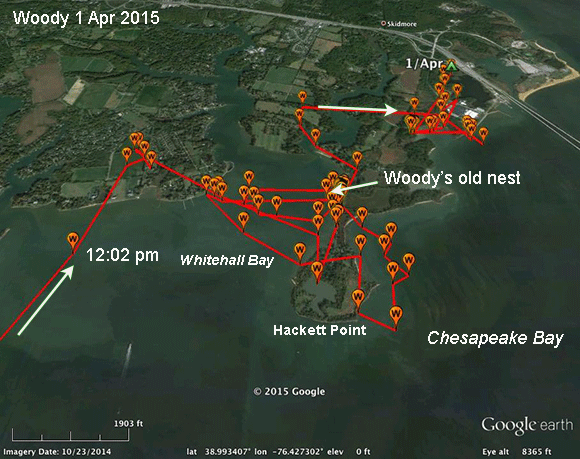 |
Home againWoody cruised into Whitehall Bay at noon on the 1st. He flew over to his nest area, where he found construction underway on a new nest platform (see below). In the afternoon, he flew north and wound up spending the night close to the toll booths for the Bay Bridge. |
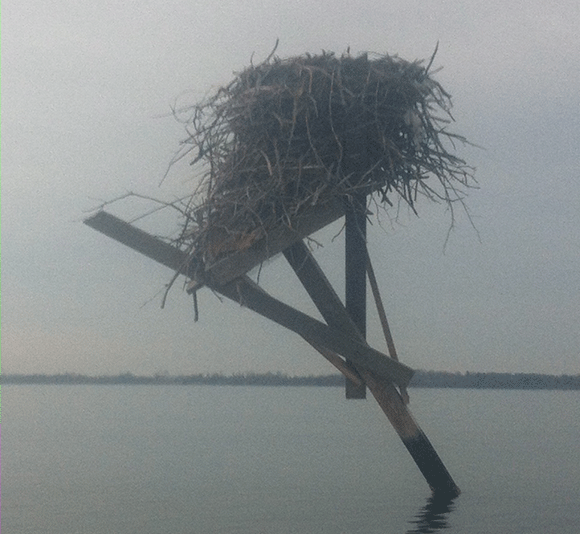 |
Woody's nestNot much of a surprise that the pole went down over the winter. Amazing that is stayed up as long as it did! |
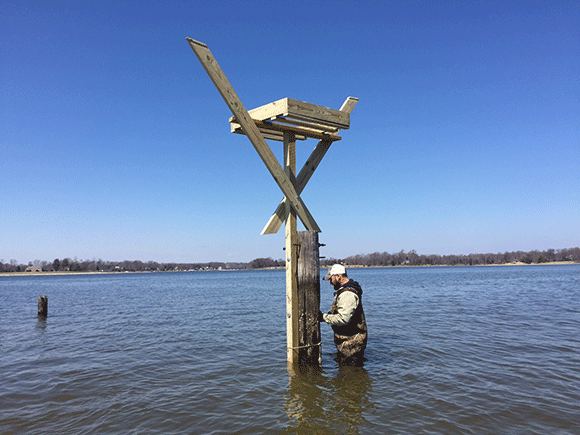 |
Woody's new nestThis one will be here for a long time. BUT, Woody's not using it. There's a pair on the nest, but Woody's not part of it. We can't tell for sure, but I suspect that Woody's female is here. Why he didn't assert himself and take the new nest is rather baffling. When Woody arrived at the end of his migration, he found the Chesapeake Bay Foundation crew installing a new nest pole. The team saw him flying around with a fish in his talons. Maybe he was so used to the old 45-degree pole that he just can't deal with one that's standing straight up! |
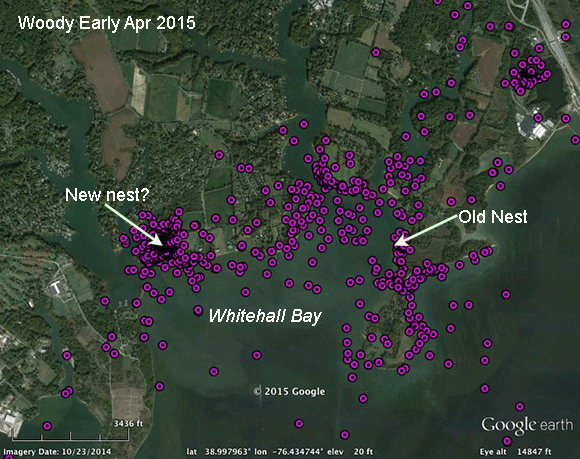 |
Woody's NEW nest?While Woody has somewhat inexplicably abandoned his old nest, he's spending a lot of time in some trees along Little Burley Creek, where Mill Creek feeds into Whitehall Bay. We'll be keeping our eyes on this spot to see if Woody can set up a nest and lure a female to it. Maybe the pair at his old nest includes a new female. If so, Woody could pair up with his old female at the new site. |